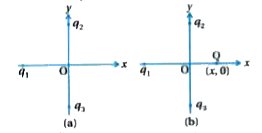Two spheres of copper, having mass 1 g each, are kept 1 m apart. The number of electrons in them are 1 % less than the number of protons. The electrical force between them is Atomic wt. of copper is 63.54 g/mol, atomic number is 29, Avogadro's number NA=6.023×1023mol−1 and k=9×109 SISolution in Gujrati
The number of electrons and protons are 29 each in neutral copper atom. The number of electrons are less than that of proton by 1%. i.e. In a charge in one atom is 0.29 e. (+ ve). The no. of atom in 1 g of copper
=Avogadro numberatomic wt.
∴n=6.023×102363.54
The positive charge in 1g of copper
q=6.023×102363.54×0.29e(∴q=ne)
∴q=439.8C
The force between two spheres.
F=kq2r2
=9×109×(439.8)2(1)2
∴F=1.74×1015 N
Topper's Solved these Questions
- BOOK - KUMAR PRAKASHANCHAPTER - ELECTRIC CHARGES AND FIELDS EXERCISE - SECTION C NCERT EXEMPLAR SOLUTION (MULTIPLE CHOICE QUESTIONS (MCQs))7videos
ELECTRIC CHARGES AND FIELDS
- BOOK - KUMAR PRAKASHANCHAPTER - ELECTRIC CHARGES AND FIELDS EXERCISE - SECTION C NCERT EXEMPLAR SOLUTION (MULTIPLE CHOICE QUESTIONS (MORE THAN ONE OPTION))6videos
ELECTRIC CHARGES AND FIELDS
- BOOK - KUMAR PRAKASHANCHAPTER - ELECTRIC CHARGES AND FIELDS EXERCISE - SECTION B NUMERICALS (ADDITONAL EXERCISE)10videos
ELECTRIC CHARGES AND FIELDS
- BOOK - KUMAR PRAKASHANCHAPTER - DUAL NATURE OF RADIATION AND MATTEREXERCISE - Section-D (MCQs asked in GUJCET/Board Exam)1videos
DUAL NATURE OF RADIATION AND MATTER
- BOOK - KUMAR PRAKASHANCHAPTER - ELECTROMAGNETIC INDUCTIONEXERCISE - Section D MCQs (MCQs asked in Competitive Exams )38videos
ELECTROMAGNETIC INDUCTION
Similar Questions
In figure, two positive charges q2 and q3 fixed along the y-axis, exert a net electric force in the + x direction on a charge q1 fixed along the x-axis. If a positive charge Q is added at (x, 0), the force on q1
 03:00View Solution
03:00View SolutionIf ∮s→E.→dS=0 over a surface, then
04:43View SolutionAn oil drop of 12 excess electrons is held stationary under a constant electric field of 2.55×104NC−1. (Millikan's oil drop experiment). The density of the oil is 1.26gcm−3. Estimate the radius of the drop, (g=9.81ms−2,e=1.60×10−19C).
02:46View SolutionMass of photon in motion is ………
02:17View SolutionThree pure inductance each of 3 H are connected as shown in figure. The equivalent inductance of this connection between points A and B is ......
 View Solution
View SolutionCalculate the total positive (or negative) charge on a 3.11 g copper penny. Given Avogadro's number =6.023xx10^(23)(g^(-1)) mol^(-1), , Given Avogadro's number and atomic mass=63.5.
View SolutionA sphere of lead of mass 10 g has net charge -25 xx 10^(-9)C . (i) Find the number of excess electrons on the sphere. (ii) How many excess electrons are per lead atom ? Atomic number of lead is 82 and its atomic mass is 207 g/mol.
01:40View SolutionIf Avogadro's number (NA) is changed from 6.022×1023mol−1 to 6.022×1020mol−1, what will be mass of 1 mole of carbon atoms ?
02:22View SolutionThe density of copper metal is 8.95 " g cm"^(-3) . If the radius of copper atom is 127.8 pm, is the copper unit cell a simple cubic, a body- centred cubic or a face- centred cubic? ( Given At. Mass of Cu= 63.54 g " mol"^(-1) and N_(A) = 6.02 xx 10^(23) " mol"^(-1))
07:14View SolutionFind the number of electrons present in an 8-g gold pin . Given : Molar mass of gold =197 g/mol , electron per atom is gold =79 and Avogadro's number =6.023xx10^23 g^(-1) mol^(-1)
04:49View SolutionFind the total negative or positive charge on a 2 g silver coin. The atomic number and atomic mass of silver is 47 and 107.9 u respectively, Given: Avogadro's number is 6.023×1023g−1mol−1 .
04:05View SolutionThe number of atoms in 0.1 mol of a triatomic gas is : (NA=6.02×1023mol−1)
03:53View SolutionCopper crystallizes into a fcc lattice with edge length 3.61 xx 10^(-8) cm. Calculate the density of the crystal (Atomic mass of copper = 63.5 g/mol and Avogadro number = 6.022 xx 10^(23) mol^(-1) )
View SolutionCopper crystallises with face-centred cubic unit cell. If the radius of copper atom is 127.8 pm, calculate the density of copper metal. (Atomic mass of Cu = 63.55 g/mol and Avogadro's number N_(A) = 6.02 xx 10^(23) mol^(-1) )
View SolutionA sphere of lead of mass 10 g has net charge −25×10−9C.
(i) Find the number of excess electrons on the sphere.
(ii) How many excess electrons are per lead atom ? Atomic number of lead is 82 and its atomic mass is 207 g/mol.View Solution

